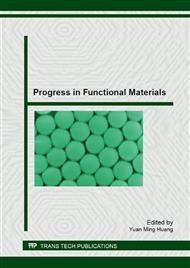p.197
p.201
p.205
p.211
p.215
p.219
p.223
p.229
p.233
Magnetic and Mössbauer Studies in Molecular-Based Magnets NBu4MAII[FeIII(OX)3](MA=Co, Fe)
Abstract:
The mixed valency character and antiferromagnetic coupling in molecule magnets materials NBu4MAII[FeIII(OX)3](MA=Co、Fe) were investigated by magnetic measurements and Mössbauer spectroscopy .In the sample NBu4CoII[FeIII(OX)3],the appearence of temperature point of spin-glass phase transition and magnetic phase transition under the zero-field-cooled AC magnetic measurements with the temperature range 5-100 K.The sample NBu4FeII[FeIII(OX)3] were carried out in the cooling modes in a field,and the sample exhibits multiple magnetic pole reversals in the warming mode magnetic measurements.The phenomenon of multiple magnetic pole reversals occurs in some of those ferrimagnetic materials consisting of magnetic anisotropy ions and two or more types of antiferromagnetically ordered magnetic ions.The compound NBu4FeII[FeIII(OX)3] contains two different spin carries; ie: Fe(II) (SFe(II) = 2), Fe(III) (SFe(III) = 5/2) comes from the Mössbauer studies.
Info:
Periodical:
Pages:
215-218
Citation:
Online since:
January 2013
Authors:
Price:
Сopyright:
© 2013 Trans Tech Publications Ltd. All Rights Reserved
Share:
Citation:


